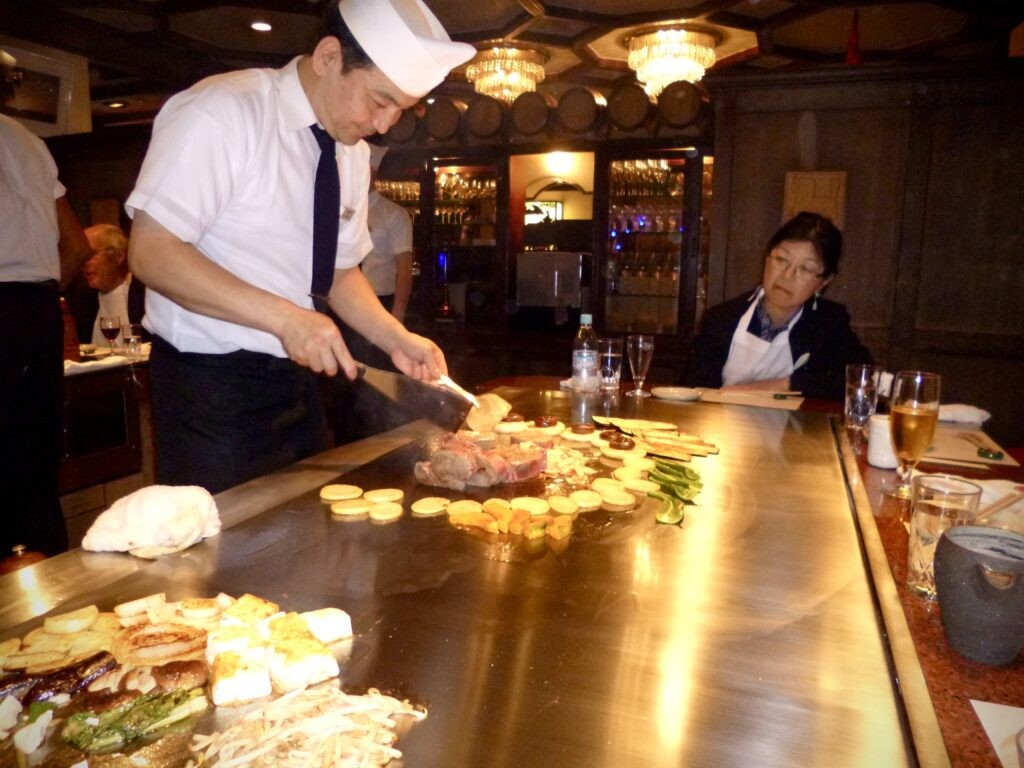Teppanyaki is more than just cooking; it’s an interactive dining experience blending culinary expertise with theatrical entertainment. Originating in Japan, this style has gained global popularity, captivating diners with sizzling grills, impressive knife skills, and skilled chefs preparing meals before their eyes. While comparable to BBQ or stir-fry, the chef’s performance truly distinguishes Teppanyaki. How many restaurants offer a chef cooking directly in front of you?
This article explores the history of Teppanyaki, from its Japanese origins to its introduction to the United States, highlighting differences between Japanese and Western styles.
Teppanyaki: Breaking Down the Name
What does “Teppanyaki” mean? The word “teppanyaki” (te-pan-yah-kee) comes from “teppan,” which means metal plate, and “yaki,” meaning grilled, fried, or pan-fried. So, literally, teppanyaki means grilling or frying on a metal plate.
Although often used interchangeably with “hibachi,” they are distinct. Both involve live cooking, but Teppanyaki is for individual or small groups, whereas hibachi is typically a communal, interactive experience.
The History of Teppanyaki: From Japan to the World
Teppanyaki’s history goes back over 200 years in Japan. While some claim it originated in steakhouses, others believe it started in Japanese homes, where families prepared stir-fried noodles.
Misono, a Kobe, Japan-based restaurant, commercialized the dining experience in 1945. Shigeji Fujioka, a Misono chef, is credited with creating the modern Teppanyaki style. The chefs wowed guests with sizzling grills, precise knife work, and impressive cooking skills.
Though inventive, Teppanyaki wasn’t initially popular with Japanese locals but became a hit with foreign tourists, drawing visitors from around the globe eager to experience this unique dining sensation, thanks to traveling businessmen. This popularity paved the way for its…
Teppanyaki’s Arrival in America
Teppanyaki reached the United States in the early 1960s, with the first restaurant opening in New York City. It offered a fusion of Japanese culinary artistry and theatrical cooking, quickly gaining popularity, leading to Teppanyaki restaurants opening across the country.
Over time, Teppanyaki restaurants became Americanized into what they are often known as today:
Japanese Steakhouses.
Many restaurants use this name for easier understanding, as many Americans aren’t familiar with “Teppanyaki.” However, the concept remains the same, and Japanese steakhouses nationwide have perfected Teppanyaki.
Now that we’ve explored Teppanyaki’s history and arrival in the U.S., let’s examine the key ingredient: the food itself.
Teppanyaki Food: Key Ingredients and Styles
If you’re asking “What Is Teppanyaki Food?”, you also need to know about the typical ingredients! There are two main Teppanyaki styles, each using different, yet delicious ingredients. The Japanese style is more traditional, while the Western style is influenced by American tastes.
Japanese Style Teppanyaki
- Yakisoba: Japanese Stir-Fried Noodles. Believed to be among the first foods used in the original form of Teppanyaki.
- Cabbage: A prevalent and widely used vegetable in Japan then and now.
- Sliced Meats: Steak, seafood, and chicken are common. Kobe beef, a high-quality cut, is also frequently used.
Western Style Teppanyaki
- Noodles or Rice: Western style often uses rice over noodles due to its easier preparation and handling.
- Chopped Vegetables: Heavy use of onions, beans, and carrots.
- Sliced Meats: Beef, chicken, and shrimp are most common, with lobster and scallops used for special dishes or upon request.
While the ingredients appear similar, a key difference lies in the cooking oil. Traditional Japanese Teppanyaki uses a combination of vegetable oil and animal fat, while Western-style typically omits animal fat.
Western-style Teppanyaki often uses tasteless oil, allowing the flavors of the food and spices to shine.
Pairing your Teppanyaki food with some refreshing sake can also enhance the dining experience.
The Art of Teppanyaki Performance
If you’ve been to a Teppanyaki restaurant, you’ve likely witnessed the impressive cooking performance. It takes skill and effort to create a delicious and entertaining experience.
- Cooking Tool Flair: A skilled chef will start with rhythmic drumming and captivating flipping of tools, typically knives and spatulas, to showcase their skills.
- Chopping and Dicing Ingredients: While much of the prep work is done beforehand, Teppanyaki chefs often perform precise cuts and slicing styles in front of guests, adding to the entertainment and facilitating cooking.
- Flaming and Cooking: The teppan grill is the center of attention, allowing guests to see their meal being cooked before their eyes. This anticipation enhances the dining experience.
Teppanyaki vs. Hibachi: Understanding the Difference
Teppanyaki and hibachi are similar, leading to the common misconception that they are the same.
The primary difference lies in the grill used. A hibachi grill is typically small, portable, and made of cast iron, while a teppanyaki grill is a large, flat griddle made of iron, allowing chefs to cook large quantities of food easily.
While both styles involve cooking in front of guests, the teppanyaki grill is most commonly found in restaurants across the U.S.
The Crucial Role of the Teppanyaki Chef
A delicious meal requires a skillful chef! The role of the Teppanyaki chef is essential in creating a memorable experience. They are skilled performers who bring the culinary stage to life, undergoing rigorous training to hone their knife skills, grilling precision, and artful presentation.
But beyond culinary skills, Teppanyaki chefs are entertainers, engaging diners with charisma, humor, and captivating showmanship. As they cook to perfection, they create a seamless performance, making every sizzle and flip part of the dining spectacle.
Their ability to combine culinary expertise with stage presence transforms a simple meal into a culinary journey and live performance.
Enjoy the Art of Teppanyaki
Teppanyaki is more than just a cooking method; it’s a captivating culinary art combining expertise with entertainment, turning each meal into a memorable experience.

